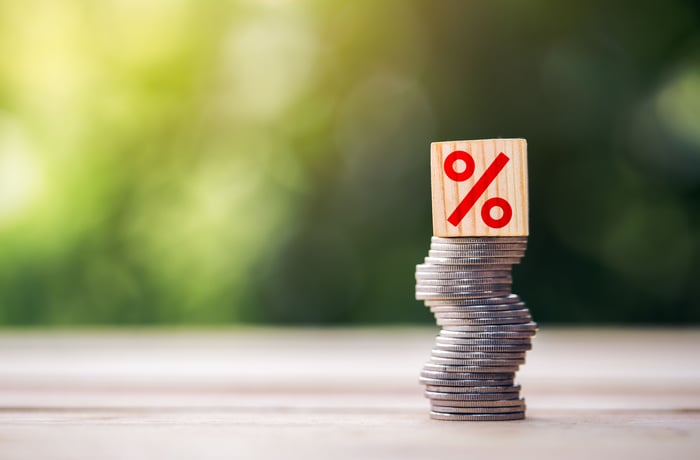Did you know there's a relatively low-risk investment that can earn you a near 7% annualized return right now?
With inflation recently at a 40-year high, there's a Treasury bond that pays an inflation-adjusted rate of nearly 7% -- the Series I Savings Bond.
While it may not be the right choice for every investor, if you're setting aside cash in a savings account on a regular basis, you might consider putting that money into I Bonds instead.

Image source: Getty Images.
I Bonds are like inflation insurance
If you're planning to hold cash for the foreseeable future, I Bonds are likely a great place to park it. Series I Treasury bonds pay interest that is based on the combination of a fixed interest rate and an inflation-adjusted rate. Every six months, the variable rate adjusts to reflect the Consumer Price Index level.
Today, the fixed-rate component for I Bonds is 0.4% while the inflation-adjusted component will be 6.89% through April 30.
This means if you buy an I Bond today, you'll be guaranteed a fixed 0.4% interest rate for the life of the bond (30 years), and an inflation-adjusted rate of nearly 7% until the end of April. It's certainly possible that the variable rate could decline beginning in May if the inflation rate heads downward, but even the fixed rate alone is higher than you'd receive from a traditional savings account.
In fact, the average interest rate for savings accounts today in the U.S. is only 0.21%, according to the FDIC.
So, if you buy an I Bond right now, you're guaranteed a better rate of return than you'd receive if you left that money in your savings account. Plus there's the added benefit of inflation insulation.
The catch with I Bonds
The biggest drawback to I Bonds is you only receive the interest payments when you cash out your bonds -- and the soonest you can do that is 12 months after you initially purchase them. Also, if you cash out before five years, you'll incur a penalty equivalent to the last three months of interest payments.
So, if you might need that money in the near future, you probably shouldn't buy I Bonds. But if you're comfortable locking up those funds for more than 12 months, there's little downside to investing in them.
Are I Bonds right for you?
The main advantage of I Bonds lies in their capacity to hold cash for long periods of time without risking a loss of purchasing power. For example, they might be an excellent savings vehicle if you're saving up to buy a home or make some other large purchase in the next several years.
The upside is your money is sheltered from inflation. The downside is your money is locked up for at least 12 months. However, if you invested those funds in the stock market, you could potentially earn a much higher rate of return.
I Bonds aren't a short-term hack
I Bonds have become increasingly popular in this period of high inflation, but it's important to understand they aren't a short-term inflation insulator.
You're obligated to hold them for at least 12 months, and even then, you'd likely be better off investing in the stock market, which has historically risen by an average of around 10% per year.
But if you're saving up for a large purchase, I Bonds do offer an attractive alternative to a traditional savings account.



